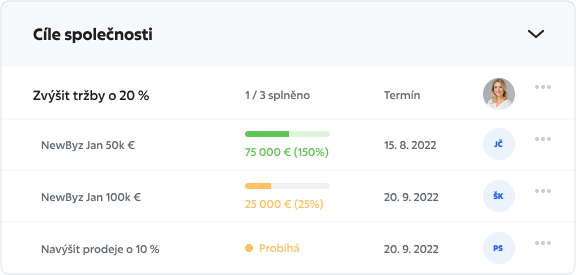OKRs
What does OKR stand for?
The mysterious acronym OKR, which was first introduced by Andy Grove, an American entrepreneur of Hungarian origin, is based on the English words Objectives, Key Results. It is a comprehensive methodology that helps leaders and organizations set and achieve their most ambitious goals.
When this methodology is properly implemented, each employee knows the direction of the company, what is expected of him or her and how he or she stands in meeting the goals. Let us now take a closer look at the individual components of the OKRs.
Source: the HR system Sloneek.
Objectives
Setting and clearly naming objectives is the first and essential prerequisite for the successful functioning of the system. These objectives should not be too technical so that they are well understood by everyone in society. Determining the metrics by which progress can be tracked is the next step. Instead, the goal should be verbal and should inspire employees to achieve it.
An example of such a goal could be: improve the website and increase conversions.
Key Results
Simply put, key results are indicators, or also metrics or indicators, that measure the success of set goals. The initial and final (desired) values are set for these metrics. At the same time, it also sets a time limit by which the KPIs are to be met.
Examples of such key indicators include:
- Increase website traffic by 10% every month.
For this indicator we set the initial value to 30, the final value is 150. The only thing left to do is to set a deadline.
Initiatives
Initiatives can be thought of as a description of what actions you will take to achieve the key indicators you have set. In other words, it is also about projects or activities that lead to success.
Examples of such initiatives include: create quality content for the web, optimize SEO.
What else to think about when creating OKRs
If you decide to use the OKR methodology, it is good to keep in mind that transparency and personal responsibility (popular terms in English are accountability or ownership) are also necessary for its successful functioning.
Transparency is about clarity of stated goals and metrics so that employees understand them, but we also talk about transparency at the level of the entire company and teams. People in the company and teams should agree on OKRs and take them at face value.
However, personal responsibility should not be perceived negatively and only pointed out when an objective is not met. Personal responsibility also offers employees the flexibility to co-create goals and specific initiatives to best match their skills and abilities.
Is there an online tool on OKR?
Of course! There are several on the market, but why not try Sloneek, which is constantly pushing the envelope in this area and also offers a comprehensive HR agenda?
In Sloneek, you can define goals and key metrics, assign people responsible for them, and track the actual performance of each metric. In addition, goals can be set not only on a company-wide level, but also individual (personal) goals can be assigned for each user.
In addition to OKRs, Sloneek also fully supports the KPI methodology. Try it all for yourself without worry for 14 days for free.
We are here for you
Can we help you?
Our experts can answer any questions, guide you through the Sloneek system and help you transform your HR into a modern all-in-one solution.
- Superior onboarding
- Introduction of all functionalities
- Presentation and offer tailored to your HR
- Answer any questions







